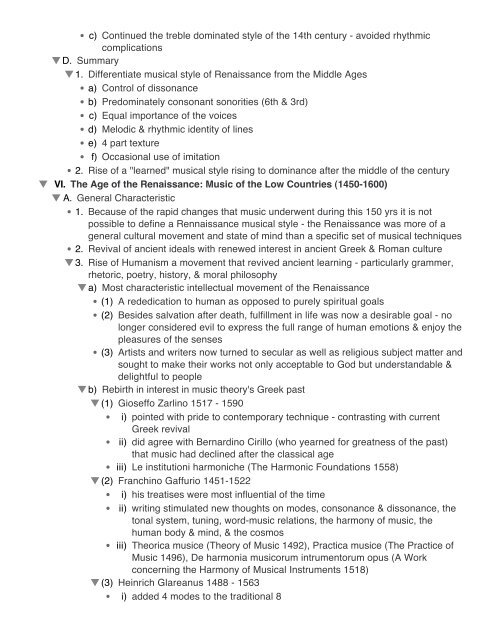An Outline of The History of Western Music Grout ... - The Reel Score
An Outline of The History of Western Music Grout ... - The Reel Score
An Outline of The History of Western Music Grout ... - The Reel Score
Create successful ePaper yourself
Turn your PDF publications into a flip-book with our unique Google optimized e-Paper software.
c) Continued the treble dominated style <strong>of</strong> the 14th century - avoided rhythmic<br />
complications<br />
D. Summary<br />
1. Differentiate musical style <strong>of</strong> Renaissance from the Middle Ages<br />
a) Control <strong>of</strong> dissonance<br />
b) Predominately consonant sonorities (6th & 3rd)<br />
c) Equal importance <strong>of</strong> the voices<br />
d) Melodic & rhythmic identity <strong>of</strong> lines<br />
e) 4 part texture<br />
f) Occasional use <strong>of</strong> imitation<br />
2. Rise <strong>of</strong> a "learned" musical style rising to dominance after the middle <strong>of</strong> the century<br />
VI. <strong>The</strong> Age <strong>of</strong> the Renaissance: <strong>Music</strong> <strong>of</strong> the Low Countries (1450-1600)<br />
A. General Characteristic<br />
1. Because <strong>of</strong> the rapid changes that music underwent during this 150 yrs it is not<br />
possible to define a Rennaissance musical style - the Renaissance was more <strong>of</strong> a<br />
general cultural movement and state <strong>of</strong> mind than a specific set <strong>of</strong> musical techniques<br />
2. Revival <strong>of</strong> ancient ideals with renewed interest in ancient Greek & Roman culture<br />
3. Rise <strong>of</strong> Humanism a movement that revived ancient learning - particularly grammer,<br />
rhetoric, poetry, history, & moral philosophy<br />
a) Most characteristic intellectual movement <strong>of</strong> the Renaissance<br />
(1) A rededication to human as opposed to purely spiritual goals<br />
(2) Besides salvation after death, fulfillment in life was now a desirable goal - no<br />
longer considered evil to express the full range <strong>of</strong> human emotions & enjoy the<br />
pleasures <strong>of</strong> the senses<br />
(3) Artists and writers now turned to secular as well as religious subject matter and<br />
sought to make their works not only acceptable to God but understandable &<br />
delightful to people<br />
b) Rebirth in interest in music theory's Greek past<br />
(1) Gioseffo Zarlino 1517 - 1590<br />
i) pointed with pride to contemporary technique - contrasting with current<br />
Greek revival<br />
ii) did agree with Bernardino Cirillo (who yearned for greatness <strong>of</strong> the past)<br />
that music had declined after the classical age<br />
iii) Le institutioni harmoniche (<strong>The</strong> Harmonic Foundations 1558)<br />
(2) Franchino Gaffurio 1451-1522<br />
i) his treatises were most influential <strong>of</strong> the time<br />
ii) writing stimulated new thoughts on modes, consonance & dissonance, the<br />
tonal system, tuning, word-music relations, the harmony <strong>of</strong> music, the<br />
human body & mind, & the cosmos<br />
iii) <strong>The</strong>orica musice (<strong>The</strong>ory <strong>of</strong> <strong>Music</strong> 1492), Practica musice (<strong>The</strong> Practice <strong>of</strong><br />
<strong>Music</strong> 1496), De harmonia musicorum intrumentorum opus (A Work<br />
concerning the Harmony <strong>of</strong> <strong>Music</strong>al Instruments 1518)<br />
(3) Heinrich Glareanus 1488 - 1563<br />
i) added 4 modes to the traditional 8





